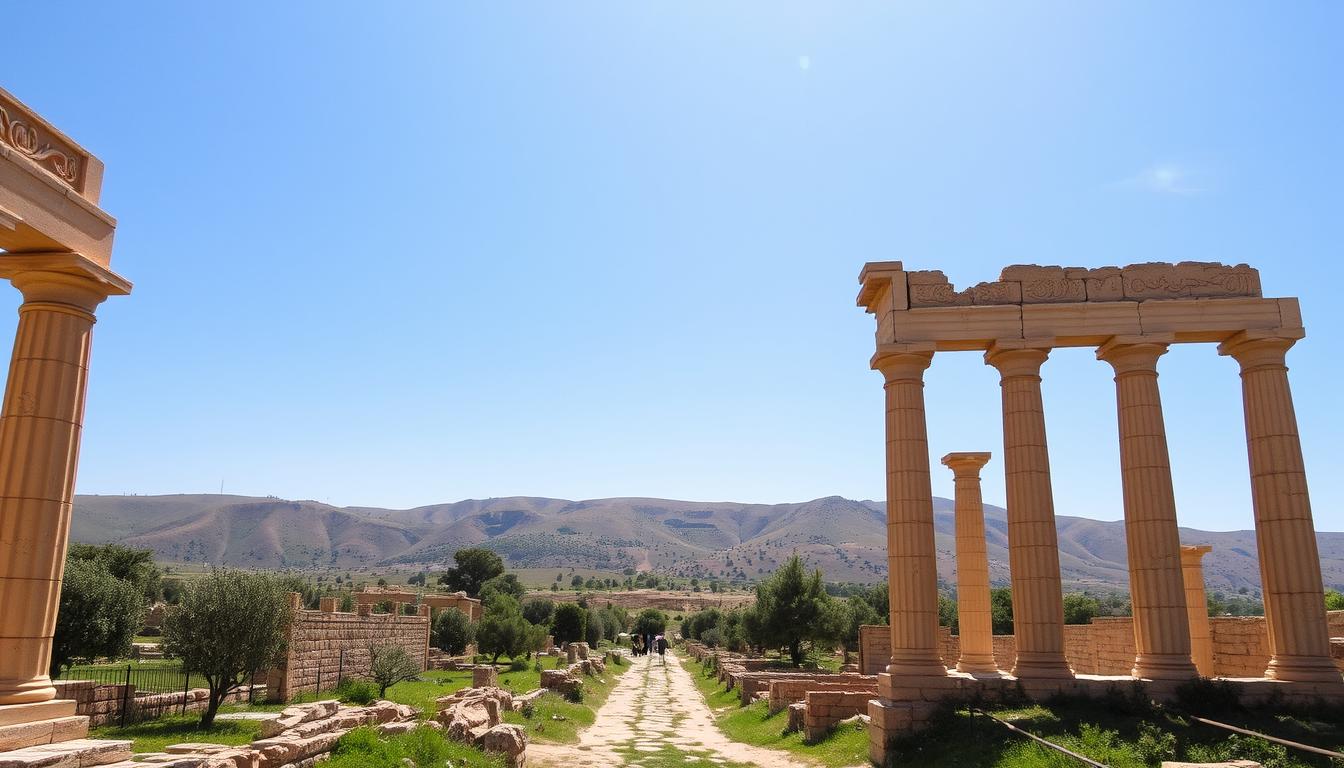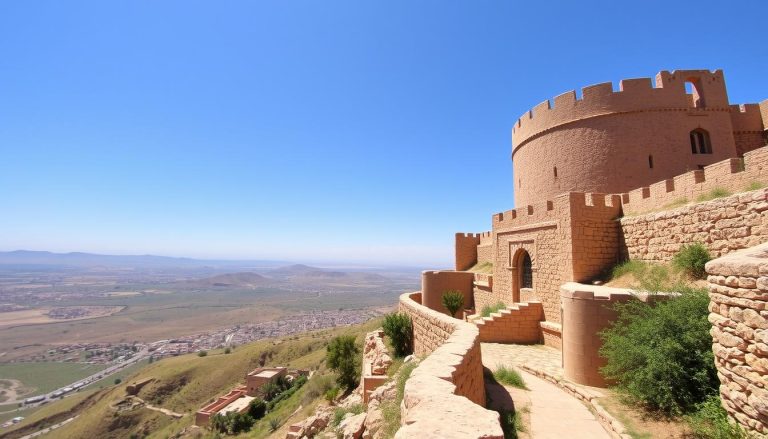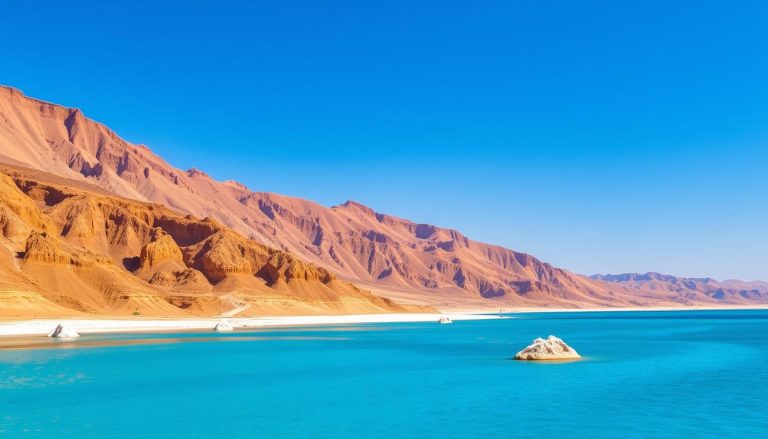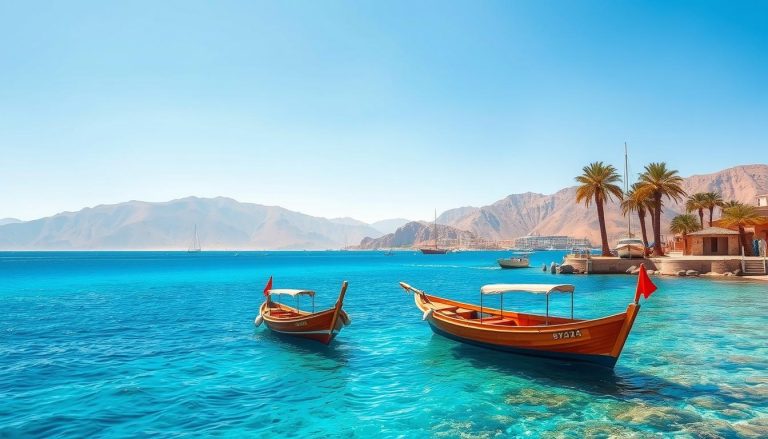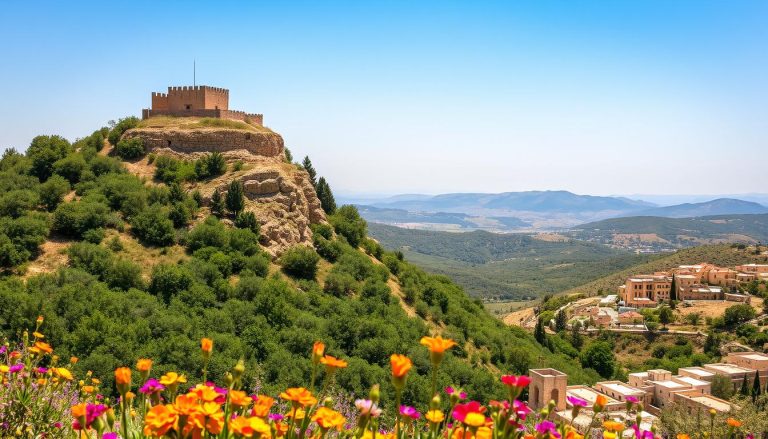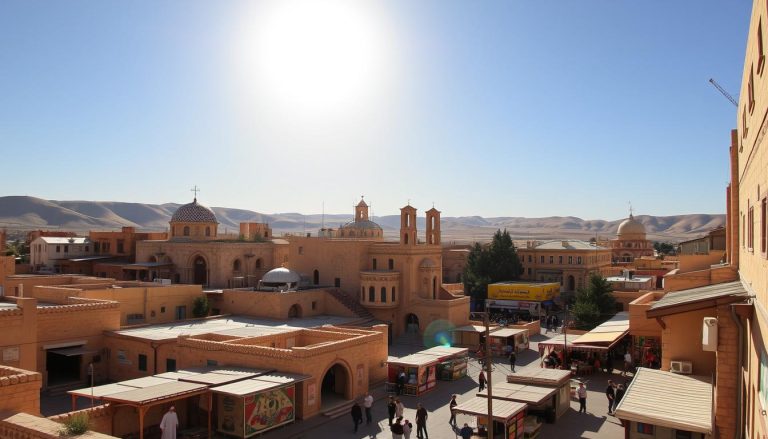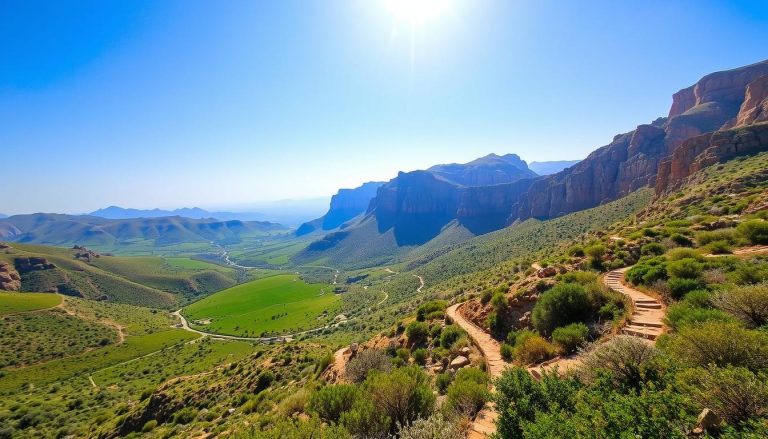Have you ever wondered about the secrets in Umm Qais, Jordan? This ancient site, once Gadara, is a window to the past. It has Greco-Roman theaters and views of the Sea of Galilee. Umm Qais is a must-see for history and nature lovers.
Key Takeaways
- Umm Qais, formerly known as Gadara, is a significant archaeological site in northern Jordan.
- The site offers a blend of Greco-Roman ruins, Ottoman-era architecture, and panoramic views of the Sea of Galilee and Yarmouk River.
- Umm Qais is renowned for its well-preserved ancient city remains, including theaters, colonnaded streets, and a Byzantine church.
- The site is associated with the biblical story of Jesus and the Gadarene swine miracle.
- Visitors can explore the ruins, visit the archaeological museum, and immerse themselves in the local culture and cuisine.
Introduction to Ancient Gadara: A Historical Overview
The ancient city of Gadara, now Umm Qais, is at the heart of Jordan’s history. Founded by the Ptolemaic dynasty in 323 BC, it started as a Decapolis city under Roman rule. This marked the beginning of Gadara’s rich past.
From Ptolemaic Foundation to Roman Glory
In the 2nd century AD, Gadara flourished under the Romans. It became famous for its culture, attracting philosophers and poets. Its location, overlooking the former Palestinian homeland, made it significant for Palestinian Jordanians.
The Ottoman Period and Modern Times
After the Muslim conquest, Gadara declined due to earthquakes. In the 19th century, a small Ottoman village grew among the ruins. This showed the area’s resilience and the lasting human presence.
Geographical Location and Significance
Gadara’s location, on a hill overlooking the Jordan Valley and Sea of Galilee, is key in its Jordanian History and Cultural Heritage. It’s a top Archaeological Tourism spot. Visitors can dive into Jordan’s history and see the legacy of this ancient city.
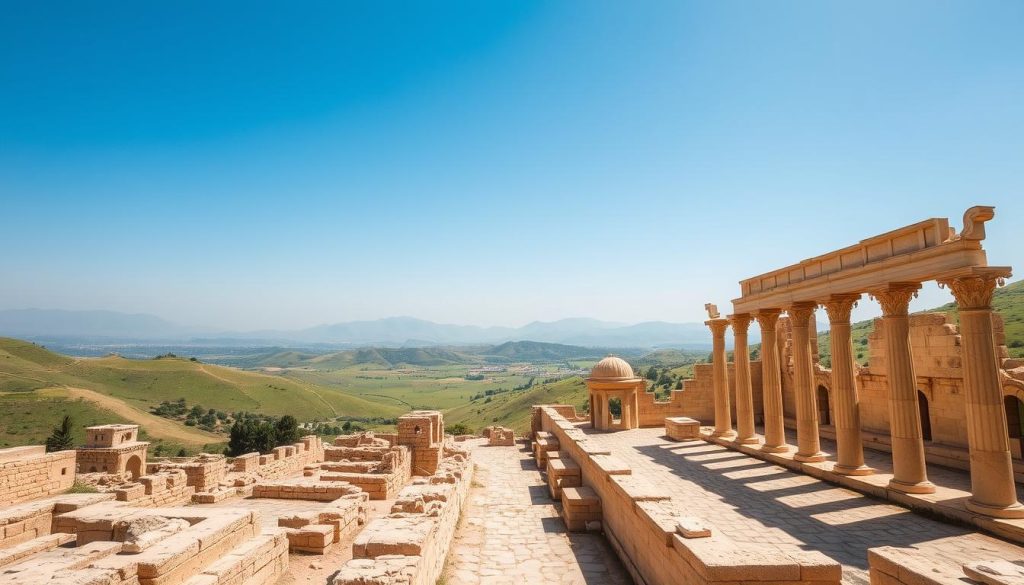
“Gadara was a city of great culture and intellectual fervor, producing renowned philosophers and poets who contributed to its reputation as a center of excellence.”
Getting to Umm Qais and Best Time to Visit
The ancient city of Umm Qais in Jordan is 30km northwest of Irbid. It’s easy to get there by car or through tours from big cities. The Jordan Travel and Middle East Tourism sectors have many tours that include Umm Qais.
The spring or autumn seasons are the best times to visit Umm Qais. The weather is mild and nice then. Weekdays are less busy than Fridays, which are favorite days for outings. The site’s views are amazing, especially at sunrise and sunset. It’s a top spot for Jordan Travel or Middle East Tourism fans.
| Location | Distance from Major Cities | Best Time to Visit |
|---|---|---|
| Umm Qais, Jordan | 30 km northwest of Irbid | Spring or Autumn |
The ruins of Gadara, now Umm Qais, show the area’s rich history and culture. When planning your Jordan Travel or Middle East Tourism trip, add Umm Qais. It’s a key part of the area’s history.
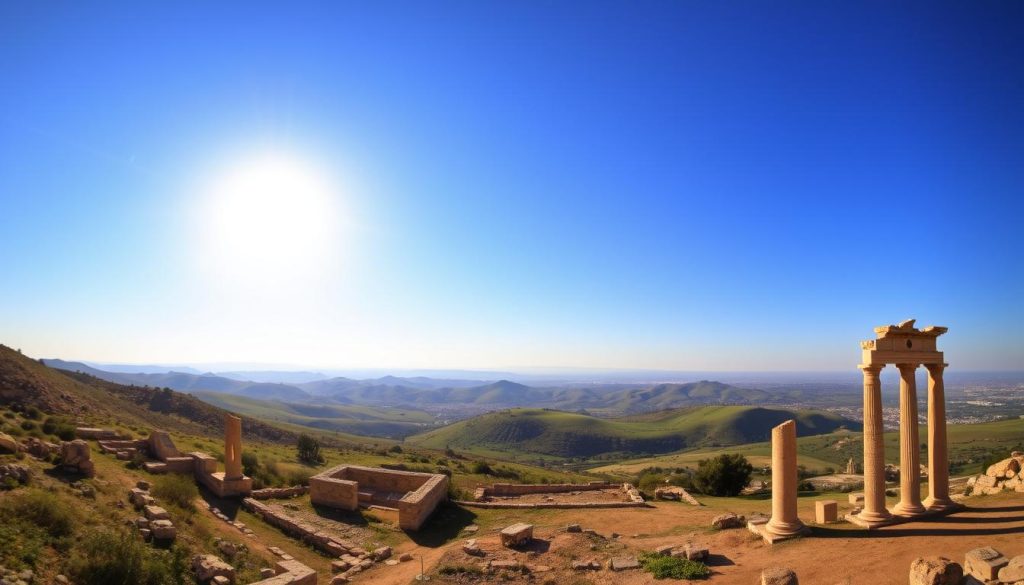
“Umm Qais offers some of the most breathtaking vistas in the Middle East, making it a must-visit destination for any traveler.”
Exploring the West Theatre and Roman Streets
In the ancient city of Umm Qais, also known as Gadara, you’ll find the West Theatre. It’s built from striking basalt and could hold up to 3,000 people. From there, you can see the ancient city layout and marvel at the Roman architecture.
The city’s Roman streets, like the Decumanus Maximus, show the Romans’ planning skills. These streets reveal the city’s layout and the Romans’ engineering.
Ancient Roman Engineering
Umm Qais shows off the Roman engineering of old. You can see a hippodrome for chariot races and monumental gateways. These were once grand entrances to the city.
Notable Archaeological Discoveries
Umm Qais has many archaeological finds. You can see statues, mosaics, and sarcophagi in the site’s museum. These items give insight into the ancient city layout and the lives of its people.
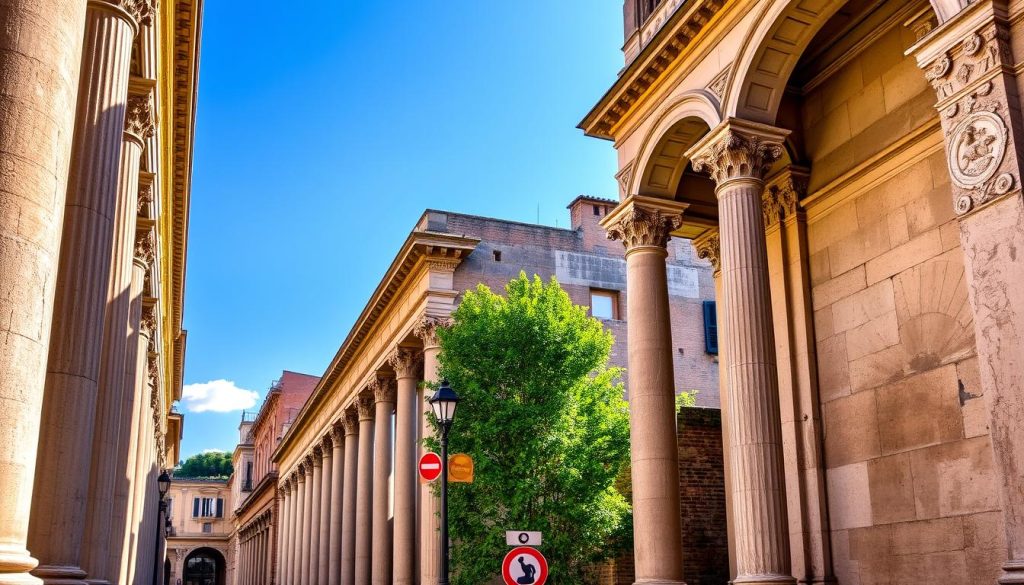
| Architectural Highlight | Description |
|---|---|
| West Theatre | A well-preserved Roman structure that could seat up to 3,000 spectators, offering panoramic views of the ancient city |
| Decumanus Maximus | The grand main street of the ancient city, showcasing the strategic planning and engineering prowess of the Romans |
| Hippodrome | The remains of a Roman-era chariot racing venue, demonstrating the advanced Roman architecture and engineering |
| Monumental Gateways | Impressive entrances that once stood as the grand portals to the ancient city of Gadara |
“The archaeological treasures of Umm Qais provide a captivating glimpse into the city’s rich Roman architecture and ancient city layout.”
The Basilica Terrace and Byzantine Church
Get ready to be amazed by the Basilica Terrace in Umm Qais, Jordan. This incredible space is carved into the rock. It has a 5th or 6th-century Byzantine church with an octagonal design, colorful tiles, and a marble altar column. As you explore, you’ll see stunning views of the Jordan Valley and the Sea of Galilee.
The Basilica Terrace shows off the area’s rich Byzantine Architecture and Christian Heritage. This architectural wonder, with its detailed design and strategic spot, lets visitors see the spiritual and cultural importance of the area back then.
“The Basilica Terrace is a hidden gem that transports you back in time, allowing you to immerse yourself in the captivating history and stunning natural scenery of Umm Qais.”
Walking through the Basilica Terrace, you’ll see the amazing craftsmanship and care put into the Byzantine church. The octagonal shape, bright tiles, and marble altar column are just a few of the architectural wonders. This place is a must-see for those who love history and art.
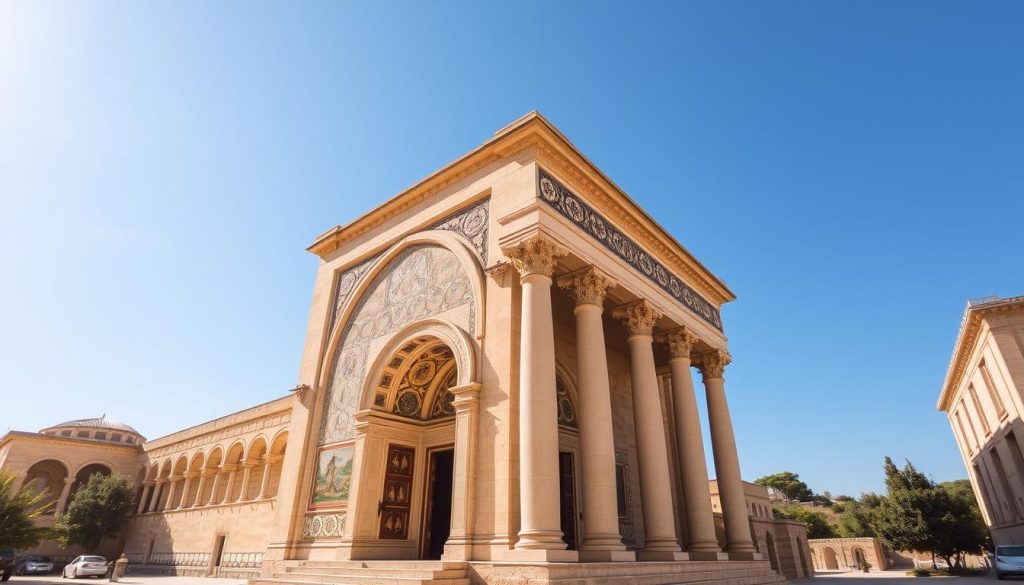
The Basilica Terrace is not just a look into the past. It’s also a great spot to see the landscape around you. Look out over the Jordan Valley and Sea of Galilee. Let the calm of this place surround you.
If you’re interested in Byzantine Architecture, drawn to Christian Heritage, or just looking for something unique and beautiful, the Basilica Terrace in Umm Qais is unforgettable.
Umm Qais, Jordan: Best Things to Do - Top Picks
In the northern reaches of Jordan, the ancient city of Umm Qais is a must-see. It’s known for its archaeological tourism and Jordan Attractions. Surrounded by hills and natural beauty, Umm Qais has lots to offer.
Visit the Archaeological Museum
Begin your journey at the site museum, an Ottoman-era building. It’s filled with treasures like statues, mosaics, and sarcophagi. These artifacts show Umm Qais’ history, from the Greco-Roman to Byzantine eras.
Explore the Ottoman Village
Next, explore the abandoned Ottoman village. It feels like time has stopped here. Walk the narrow streets, seeing the old houses. It’s a chance to connect with history.
Photography at Scenic Viewpoints
Don’t miss the stunning views at Umm Qais. The viewpoints offer amazing sights of the Sea of Galilee, Golan Heights, and Yarmouk Gorge. It’s perfect for taking beautiful photos.
“Umm Qais offers a unique blend of archaeological wonders and natural splendor, making it a must-visit destination for those seeking to immerse themselves in Jordan’s captivating history and landscapes.”
Natural Wonders of Yarmouk Nature Reserve
Nestled near the captivating ruins of Umm Qais, the Yarmouk Nature Reserve is a true gem for nature enthusiasts exploring Jordan. Established in 2010, this 20-square-kilometer reserve protects a diverse range of natural wonders. From lush deciduous oak forests to rare orchids, the landscape is breathtaking.
The reserve is home to an array of wildlife, including the elusive otter, the majestic hyena, and the graceful mountain gazelle. Hiking trails and mountain biking opportunities allow visitors to immerse themselves in this stunning natural environment. It’s a chance to disconnect from the hustle and bustle and connect with the Jordan Nature Reserves.
But Yarmouk Nature Reserve is more than just a haven for outdoor recreation. It also serves as an important environmental education center. Visitors gain insights into the region’s rich biodiversity and the vital role it plays in the local Eco-Tourism ecosystem. Whether you’re a seasoned naturalist or seeking a peaceful respite, this reserve promises to leave a lasting impression.
| Key Facts about Yarmouk Nature Reserve | Details |
|---|---|
| Location | Near the ancient city of Umm Qais, Jordan |
| Established | 2010 |
| Size | 20 square kilometers |
| Ecosystem | Deciduous oak forests, rare orchids, diverse wildlife |
| Attractions | Hiking trails, mountain biking, environmental education |
Whether you’re seeking a peaceful escape or an opportunity to reconnect with nature, the Yarmouk Nature Reserve is a must-visit. Pack your hiking boots, grab your camera, and get ready to immerse yourself in the captivating beauty of this remarkable Jordan Nature Reserves.
Dining and Local Experiences
Visiting Umm Qais in Jordan is a treat. You’ll dive into the Jordanian food and local culture. Enjoy traditional dishes and meet artisans and community members. These experiences will show you the area’s heritage and modern life.
Traditional Jordanian Cuisine
Umm Qais is famous for its Jordanian food. Local restaurants serve dishes like mansaf (lamb in yogurt sauce) and mujadara (rice and lentils). You’ll also find mezze, with hummus, moutabal (eggplant dip), and fattoush (a salad with pita chips).
Restaurant Recommendations
For a real taste of Jordan, try Beit Al Zahra in Umm Qais. They use local ingredients in their classic dishes. Al Qalaa Restaurant is also great. It has amazing views of the ruins and the Golan Heights.
Local Cultural Experiences
Umm Qais is full of cultural activities. You can see community projects that help women and people with disabilities. They make crafts like baskets and pottery. These experiences teach you about the area’s history and help the community.
| Jordanian Dish | Description |
|---|---|
| Mansaf | Lamb cooked in a yogurt sauce, often served with rice and garnished with pine nuts and parsley. |
| Mujadara | A comforting dish made with rice, lentils, and caramelized onions, seasoned with cumin and cinnamon. |
| Mezze | A selection of small plates, including hummus, moutabal (eggplant dip), and fattoush (a fresh salad with pita chips). |
“Exploring the local cuisine and cultural experiences in Umm Qais was the highlight of my trip to Jordan. It truly immersed me in the rich traditions of the region.”
Accommodation Options Near Umm Qais
Visiting Umm Qais in northern Jordan offers many places to stay. You can choose from cozy eco-lodges or hotels in nearby cities. Each option helps make your visit to this ancient site better.
The Beit Al Baraka guesthouse in Umm Qais has a room for three. You can enjoy dinner in the cozy living room. But, remember the ruins close by 6 p.m. and the guesthouse lights go off at 9 p.m.
For a city vibe, stay in Irbid or Amman. These cities have many Jordan Hotels. The Bristol Hotel in Amman is a luxury spot near the city center.
The Ziglab Ecopark offers a special eco-lodge experience. It’s near Umm Qais and lets you enjoy nature and local culture.
Book your stay early, as Umm Qais is popular. You’ll find everything from guesthouses to modern hotels. This ensures a great base for exploring Umm Qais and more.
Conclusion
Umm Qais is a gem in Jordan’s north, blending history, culture, and nature. It’s a top spot for anyone visiting the Middle East. You’ll find ancient Roman ruins and breathtaking views of the Golan Heights here.
Exploring Umm Qais, you’ll learn about Gadara’s past. This city was important in the Decapolis league during the Hellenistic and Roman times. The West Theatre, Byzantine Basilica, and other sites show the area’s rich history. The local museum is full of artifacts that tell Umm Qais’ story.
The Yarmouk Nature Reserve is a natural wonder nearby. It has forests and wildlife, perfect for outdoor fun. Whether you’re looking for travel tips in Jordan or exploring Middle East tourism, Umm Qais will amaze you. Start your journey and see why this place is so special in the Levant.
